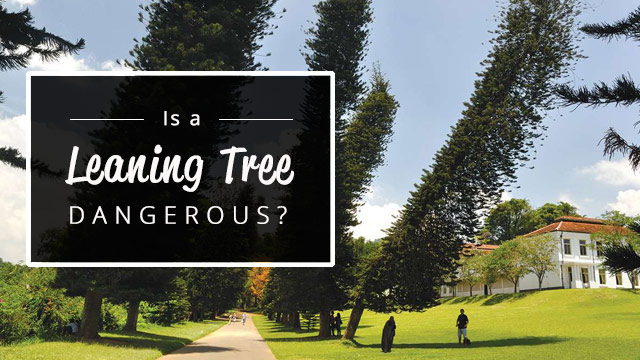We get lots of questions from homeowners about leaning trees1, so I thought I would put together a post to answer the most common questions and concerns that have come up in the past.
It’s a very general question and it does depend on the severity of the tree’s lean and whether the tree actually grew like that, or the lean has developed recently due to a storm or other mechanical damage.
Trees that have grown with a lean are generally pretty safe. If the lean has developed seemingly overnight, this can be cause for concern as the tree may be dangerous and need removal.

As a tree grows, sometimes there is not enough light directly above so the tree will grow towards the light developing a lean. Other times it will just be a structural thing with that particular specimen or the species in general. With most of its weight on one side of the tree, counterbalance roots will be sent out in the opposite direction to anchor the tree better.
Trees that have recently developed a lean are considered dangerous and you should consult your local arborist to take a better look at it and get their advice on whether or not your tree should be removed. If the tree has recently developed a lean after a storm and it is leaning over your house, I would consider this a serious situation or an emergency that needs immediate attention.
What we cover
ToggleWhat causes a tree to develop a lean?
In most cases, trees will naturally grow upright unless they are planted in a spot that does not get a lot of light. In those cases, the tree will naturally grow towards the light causing a lean. As mentioned, these trees are quite safe.
One of the most common causes3 of a tree to develop a lean over a short period of time is during strong winds and or heavy rains. The perfect combination for a tree to develop a lean or completely full over is with sustained periods of rain that soften the ground followed by a stiff wind that will easily topple the tree.
Trees are generally quite intelligent in the way they grow and will do so with very good weight distribution. If this is not possible and they must grow in one direction, they grow their roots in the opposite direction of the lean to compensate for that and stay upright.
There are times however when a tree will grow in an asymmetrical fashion for no apparent reason and have way too much weight on one side. This is more common in some trees than others. Eucalyptus nicholii is a perfect example. They almost always grow with a lean and are also shallow rooted which makes them a perfect candidate to come over in a strong wind.
Can a leaning tree be saved?
A lot of the time the tree with the lean can be saved2. That does not always mean you can straighten the tree up, but it doesn’t mean it can be trimmed in a way to remove a lot of the weight from one side to make it a lot safer for the tree to remain. This will depend, however, on how the lean has developed and how large the tree is.
If the lane has developed over time from uneven weight distribution, then it is quite easily fixed by taking some weight off the offending side. If the tree has developed a lean after a storm it means the whole structure including the root system is not sound and will most likely need to be removed.
I would contact your local tree surgeon for a second opinion as they will be able to tell you whether the tree can be saved or not.
Can a leaning tree be straightened?
Depending on the size of a tree leaning tree can be straightened. For a smaller tree that still has not reached its full potential, you can stake or brace a tree allowing it to take better root.
If the tree is a huge pine tree for example that has reached maturity and weighs several tonnes, then the likelihood of straightening the tree and it being structurally sound is very unlikely. In this case, the trees are best off being removed.





Is cable bracing a good idea?
I personally am not a huge fan of cable bracing. I think if a tree does not have a good structure to begin with, then cable bracing is just a Band-Aid and the problem will only get worse in time.
That being said if it’s only a small ornamental tree no bigger than 15ft. I don’t see it being a huge issue as a failure of the tree structure will not result in any major damage or injury.
Also if you are using the cable bracing technique to try and eek a few more years out of a failing tree that is clearly in decline, then I am dead against it. Trees in an urban environment have a certain amenity value and Safe and Useful Life Expectancy. Once the tree has passed that, you are only delaying the inevitable. In my opinion, you are best removing the tree and replacing it with a new sapling.
What are the chances of a leaning tree falling on my house?
If the trees leaning toward your house it is definitely a concern and I would consider having them removed. If the tree grew like that, then by just removing some branches you can make it more structurally sound and the likelihood of falling can be decreased drastically. But if the tree had developed a lean overnight due to a storm or other mechanical damage, then the likelihood of it falling on your house is high. I myself would not attempt to try and rectify the tree but rather have the tree removed and plant another in its place.
Whenever a tree looks unsafe, you are always best getting a tree inspection carried out by a qualified arborist to get their professional opinion on what your next move should be. They will soon tell you whether your tree is dangerous and should be removed.
I would always get a second opinion and not just take the word of one arborist. This industry is full of unqualified gardeners posing as arborists, so I would make sure they are qualified arborists so their opinion truly counts.
- Scott A Sjolander and Brian Wolyniak, (2023) What to Do About Leaning Trees. <https://extension.psu.edu/what-to-do-about-leaning-trees> Accessed: 21-02-2024
- Davey Tree, (2021) Can You Save a Leaning Tree? <https://blog.davey.com/can-you-save-a-leaning-tree/> Accessed: 21-02-2024
- mcclainstree Admin, (2020) Leaning Trees Causes and Corrections. <https://www.mcclainstreeexperts.com/leaning-trees-causes-and-corrections> Accessed: 21-02-2024




